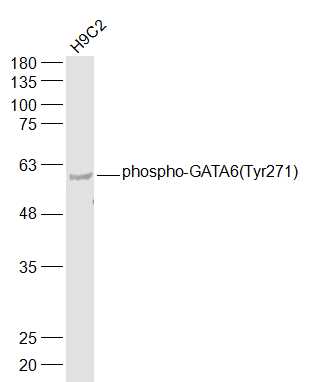
Rabbit Anti-phospho-GATA6 (Tyr271)antibody
GATA6 (phospho Tyr271); GATA6 (phospho Tyr271); Gata binding factor 6; Gata binding protein 6; GATA-binding factor 6; Gata6; GATA6_HUMAN; Transcription factor Gata 6; Transcription factor GATA-6.
View History [Clear]
Details
Product Name phospho-GATA6 (Tyr271) Chinese Name 磷酸化GATABinding protein6抗体 Alias GATA6 (phospho Tyr271); GATA6 (phospho Tyr271); Gata binding factor 6; Gata binding protein 6; GATA-binding factor 6; Gata6; GATA6_HUMAN; Transcription factor Gata 6; Transcription factor GATA-6. Product Type Phosphorylated anti Research Area Tumour Cardiovascular Cell biology immunology Developmental biology Chromatin and nuclear signals Stem cells transcriptional regulatory factor Binding protein Epigenetics Immunogen Species Rabbit Clonality Polyclonal React Species Rat, (predicted: Human, Mouse, Dog, Pig, Cow, Sheep, ) Applications WB=1:500-2000 ELISA=1:5000-10000 IHC-P=1:100-500 IHC-F=1:100-500 IF=1:100-500 (Paraffin sections need antigen repair)
not yet tested in other applications.
optimal dilutions/concentrations should be determined by the end user.Theoretical molecular weight 60kDa Cellular localization The nucleus Form Liquid Concentration 1mg/ml immunogen KLH conjugated Synthesised phosphopeptide derived from human GATA6 around the phosphorylation site of Tyr271: GL(p-Y)SK Lsotype IgG Purification affinity purified by Protein A Buffer Solution 0.01M TBS(pH7.4) with 1% BSA, 0.03% Proclin300 and 50% Glycerol. Storage Shipped at 4℃. Store at -20 °C for one year. Avoid repeated freeze/thaw cycles. Attention This product as supplied is intended for research use only, not for use in human, therapeutic or diagnostic applications. PubMed PubMed Product Detail GATA-6(GATA binding factor 6)is zinc-finger transcription factor that binds DNA at GATA regions; Involved in gene regulation specifically in the gastric epithelium. Cellular localization:Nuclear. Tissue Specificity: gastric epithelium.
Function:
Transcriptional activator that regulates SEMA3C and PLXNA2. Thought to be important for regulating terminal differentiation and/or proliferation.
Subunit:
Interacts with LMCD1 (By similarity).
Subcellular Location:
Nucleus.
Tissue Specificity:
Expressed in myocardium, vascular smooth muscle, gut epithelium, and osteoclasts.
DISEASE:
Defects in GATA6 are a cause of conotruncal heart malformations (CTHM) [MIM:217095]. A group of congenital heart defects involving the outflow tracts. Examples include truncus arteriosus communis, double-outlet right ventricle and transposition of great arteries. Truncus arteriosus communis is characterized by a single outflow tract instead of a separate aorta and pulmonary artery. In transposition of the great arteries, the aorta arises from the right ventricle and the pulmonary artery from the left ventricle. In double outlet of the right ventricle, both the pulmonary artery and aorta arise from the right ventricle. Note=GATA6 mutations have been found in patients with non-syndromic persistent truncus arteriosus (PubMed:19666519).
Defects in GATA6 are the cause of atrial septal defect type 9 (ASD9) [MIM:614475]. A congenital heart malformation characterized by incomplete closure of the wall between the atria resulting in blood flow from the left to the right atria. Some patients manifest tricuspid valve disease, pulmonary valve disease, and pulmonary artery hypertension.
Defects in GATA6 are a cause of tetralogy of Fallot (TOF) [MIM:187500]. A congenital heart anomaly which consists of pulmonary stenosis, ventricular septal defect, dextroposition of the aorta (aorta is on the right side instead of the left) and hypertrophy of the right ventricle. In this condition, blood from both ventricles (oxygen-rich and oxygen-poor) is pumped into the body often causing cyanosis.
Defects in GATA6 are the cause of atrioventricular septal defect type 5 (AVSD5) [MIM:614474]. A congenital heart malformation characterized by a common atrioventricular junction coexisting with deficient atrioventricular septation. The complete form involves underdevelopment of the lower part of the atrial septum and the upper part of the ventricular septum; the valve itself is also shared. A less severe form, known as ostium primum atrial septal defect, is characterized by separate atrioventricular valvar orifices despite a common junction.
Defects in GATA6 are a cause of pancreatic agenesis and congenital heart defects (PACHD) [MIM:600001]. An autosomal dominant disease characterized by pancreatic severe hypoplasia or agenesis, diabetes mellitus, and congenital heart abonormalities including ventricular septal defect, patent ductus arteriosus, pulmonary artery stenosis, truncus arteriosus and tetralogy of Fallot.
Similarity:
Contains 2 GATA-type zinc fingers.
SWISS:
Q92908
Gene ID:
2627
Database links:Entrez Gene: 2627 Human
Entrez Gene: 14465 Mouse
Omim: 601656 Human
SwissProt: P43693 Chicken
SwissProt: Q92908 Human
SwissProt: Q61169 Mouse
Unigene: 514746 Human
Unigene: 329287 Mouse
Unigene: 8701 Rat
Product Picture
References (0)
No References
Bought notes(bought amounts latest0)
No one bought this product
User Comment(Total0User Comment Num)
- No comment



 +86 571 56623320
+86 571 56623320
 +86 18668110335
+86 18668110335

